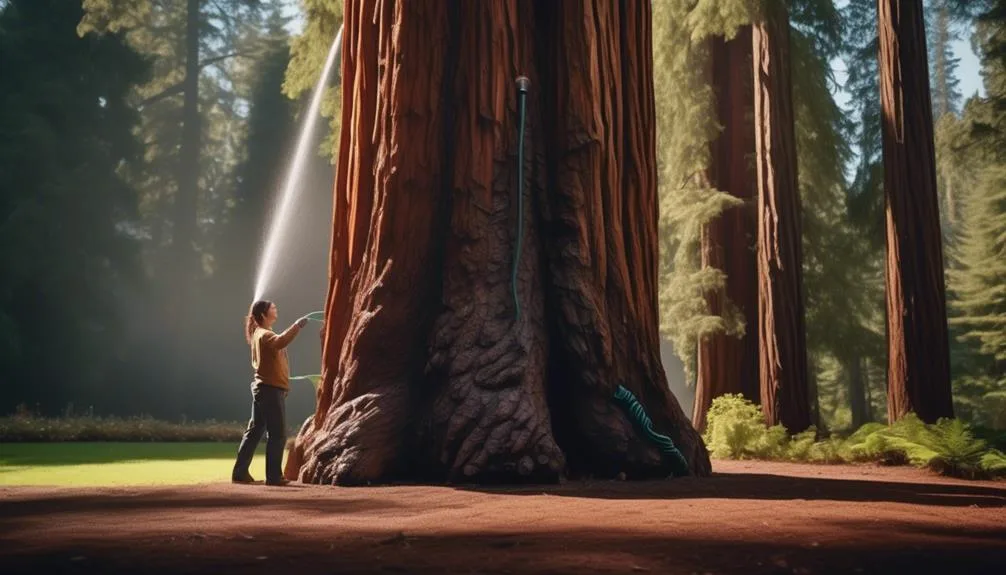Properly watering redwood trees is crucial for their health and longevity. It's not just about the amount of water, but also about the timing, technique, and understanding the tree's specific needs.
Imagine it like quenching the thirst of a giant – a big task, but manageable with the right knowledge.
Let's explore the key factors in watering these majestic trees to ensure they thrive in their environment.
Watering Frequency
To ensure the health and vitality of your redwood trees, it's crucial to establish an appropriate watering frequency based on their individual needs.
Redwood trees have shallow root systems, typically extending only 6-12 inches deep in the soil. This means frequent, shallow watering is essential to reach the entire root system.
During the dry season, it's recommended to water redwood trees deeply and infrequently, allowing the soil to dry out between watering sessions to encourage deep root growth.
A general rule of thumb is to provide 1 inch of water per week, adjusting based on weather conditions.
To determine the watering schedule, consider factors such as soil type, tree age, and local climate.
Soil Moisture Levels
Maintain optimal soil moisture levels to support the health and vigor of your redwood trees, ensuring their shallow root systems receive the necessary hydration for sustained growth. Understanding the root depth and evaporation rates will help you achieve this goal effectively.
- Root Depth: Redwood trees have shallow root systems, typically extending only 5-6 feet deep but spreading widely, often up to 100 feet from the base. This means the moisture needs to reach a broad area to support the entire root network.
- Evaporation Rates: In regions with high temperatures or low humidity, the soil moisture can evaporate quickly. It's crucial to monitor and adjust watering frequency to compensate for these evaporation rates, especially during hot, dry periods.
Proper Irrigation Techniques
Ensure that you're applying water deeply and evenly around the base of the redwood trees to reach their extensive root system. Redwood trees have a shallow root depth but also develop deep taproots, so it's crucial to water them effectively.
One of the best watering methods for redwoods is to use a soaker hose or drip irrigation system. These methods deliver water directly to the root zone, promoting deep root growth and preventing water wastage through evaporation.
When using a soaker hose, place it in a spiral pattern around the tree, gradually moving it outwards as the tree grows. For drip irrigation, position the emitters in a circle around the tree, ensuring even coverage.
Proper irrigation techniques not only ensure the health and vitality of the redwood trees but also conserve water by minimizing runoff and evaporation.
Seasonal Considerations
Consider adjusting the frequency and duration of watering as the seasons change to accommodate the varying moisture needs of the redwood trees.
In summer, when the weather is hot and dry, it's crucial to water the redwood trees more frequently. Aim to water deeply, allowing the water to penetrate the soil and reach the tree's roots.
During winter, while the redwood trees are dormant, they still require hydration. However, the frequency of watering should be reduced, as the tree's water consumption is lower during this season.
Be mindful of these seasonal changes to ensure the optimal health of your redwood trees throughout the year.
- Summer watering: Increase frequency and depth of watering.
- Winter hydration: Reduce watering frequency while ensuring adequate moisture.
Signs of Overwatering or Underwatering
If your redwood trees are showing signs of overwatering or underwatering, it's important to recognize these indicators early to adjust your watering practices accordingly.
Overwatering can lead to leaf discoloration, often appearing as yellow or brown spots on the leaves. You may also notice wilting, where the leaves droop or curl even though the soil is moist. Additionally, root rot and soil compaction are common issues associated with overwatering.
On the other hand, underwatering may cause the leaves to become dry, crispy, or even fall off prematurely. This can also lead to stunted growth and a weakened root system.
Conclusion
In nurturing your redwood trees with mindful watering and keen observation, you're fostering their long-term health and vitality. By tending to soil moisture, adapting to seasonal changes, and adjusting as needed, you're investing in the enduring beauty of these majestic trees.
How will your thoughtful care for your redwoods inspire a deeper connection to nature and the environment? Keep nurturing and witnessing the thriving legacy of your redwood trees.
Mark Hoffman is a dedicated arborist and tree care specialist with over a decade of experience. His love for trees began when he visited Yosemite National Park as a teenager and was awestruck by the giant sequoias. Mark pursued his passion by studying forestry at Michigan Technological University, where he earned a Bachelor of Science degree.
Since then, he has worked tirelessly in the field of arboriculture, helping to preserve and protect trees in his community. His expertise and dedication have made him a respected leader in the industry and a valuable resource for anyone seeking advice on tree care.
